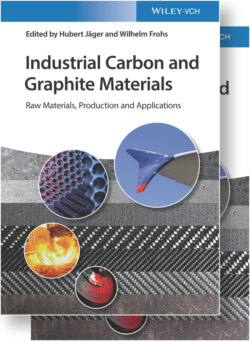Читать книгу Industrial Carbon and Graphite Materials - Группа авторов - Страница 275
6.1.2.2.2 Chemical Properties and Composition
ОглавлениеUnder normal conditions petroleum coke has a low reactivity. At higher temperature (up to 1400 °C under calcination conditions), an expansion of the crystallite size up to 2.5–3.5 nm takes place because of the cracking of side chains. At the same time the original hydrogen content of approximately 3.5 wt% is reduced to below 0.1 wt%. Under graphitization conditions (approximately 2900 °C), good crystallized forms of petroleum coke (needle coke character) are transformed into graphites. These graded changes in quality of petroleum coke with temperature demonstrate the structure, character, and classification of the product very likely.
The dominant element in petroleum coke is carbon. The hydrogen content is around 3.5 wt%. Sulfur and nitrogen from the feed components concentrate in the petroleum coke (S content of petroleum coke 0.1–7.5 wt%; N content 0.2–1.5 wt%). The V and Ni contents (0.001–0.1 wt%) of the feed streams remain almost entirely in the petroleum coke. The Na, Ca, and Mg content in the petroleum coke is the sum of the content of these cations in the crude oil and of their concentration in the cutting water (Section 6.1.1).
The level of polycyclic aromatics in petroleum coke is about 250 mg/kg. Benzo (a) pyrene makes up about 25 mg/kg. The amount of heavy metals, apart from V and Ni, is insignificant (<1 mg/kg). In general the quality of the feed components and the production conditions determine the quality of the product.
Petroleum coke is generally considered nontoxic and nonhazardous. According to the 21st ATP (Adaptation of Technical Progress of the European Substance Directive) and CONCAWE product dossier No. 93/105 and 95/95 [3], petroleum coke is considered a nondangerous product. In the Second ATP (Adaption to Technical Process to the CLP Regulation) Commission Regulation EU No. 286/2011, Brussels, Petroleum Coke. In the guidance “Classification and Labelling of Petroleum Substances (CLP) according to the EU Dangerous Substances Directive (CONCAWE recommendations August 2001),” the summary of classification and labeling recommendations for petroleum coke is that no classification and labeling required. The American Petroleum Institute (API) in the report “Petroleum Coke Category Analysis and Hazard Characterization (December 2007)” gives the conclusions: Both green coke and calcined coke have a low potential to cause adverse effects to the environment and human health, with the exception of noncompound‐specific, insoluble particle‐portal‐of‐effects. The level of polycyclic aromatics in petroleum coke is about 250 mg/kg. Benzopyrene makes up about 25 mg/kg. The amount of heavy metals, apart from V and Ni, is insignificant (<1 mg/kg). In general the quality of the feed components and the production conditions determine the quality of the product.
